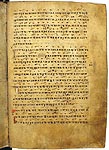Notated Menaion Sticherarion.
1156-1163. Novgorod
F (265 ı 185). I+114 leaves.
Parchment. Ink, cinnabar.
It is written in a uncial script by several hands (change of handwriting on fols. 99r, 100v, 101r, 107r). .
Znamenny notation without red-ink marks (known as the Shaidurov's marks) and black line-signs (the priznaki of Mezenets). Text on folios 74v, 97r has the signs of Kondakarian notation. The conditional notation are on folios 109r, 110r-110v, 112v-113r.
There are initials in the Old Byzantine style cinnabar and ink. Folios 101 has pen-and-ink drawings: a horseman (Saint George ?) and a person wearing a cassock (?).
Folio 99r bears the scribe's inscription stating that his work was ended on 13 Septemper, on the eve of the feast of the Exaltation of the Cross, under Bishop Arkady and under the tiun Tupochel.
According to the inscription, the book was produced in Novgorod during the reign of Bishop Arkady of Novgorod (1156-1163), so the creation of this Sticherarion can be dated between 1156-1163. The representatives of ecclesiastic authority and temporal power are named in the inscription. At that the highest Novgorod hierarch (bishop) ranks on a par with the tiun (in this context - the mayor of the city) - the third official person in order of importance after the Prince and the governor. Since, neither one nor the other are mentioned in the record, they both were absent in Novgorod when the book was completed. Such situation occurred in winter of 1160, when Prince Sviatoslav Rostislavovich of Novgorod was exiled to Ladoga by Novgorod citizens, but the new Prince Mstislav Rostislavovich began to rule only in summer (on 21 June). In winter of the same year the governor was also replaced (the First Chronicle of Novgorod . Ã., 2000. —. 30-31). This information allows for dating the manuscript more accurately. Judging from all this, the scribe's work was ended in winter of 1160.
This musical manuscript is among the most complete earliest Menaion Sticherarion. It was written 103 years after the Ostromir Gospel. It is one of few manuscripts of vocal music to have survived from the period, which is the nearest to the date of creation of Ostromir Gospel. Contents of the manuscript correspond with the Orthodox Liturgical Calendar in the Gospel and contains stichera for use in selected feasts of the church year.
In 1919 the manuscript came into the State Public Library along with the collection of St Sophia's Cathedral in Novgorod.
Shelfmark: –Õ¡. —ÓÙ. 384.





